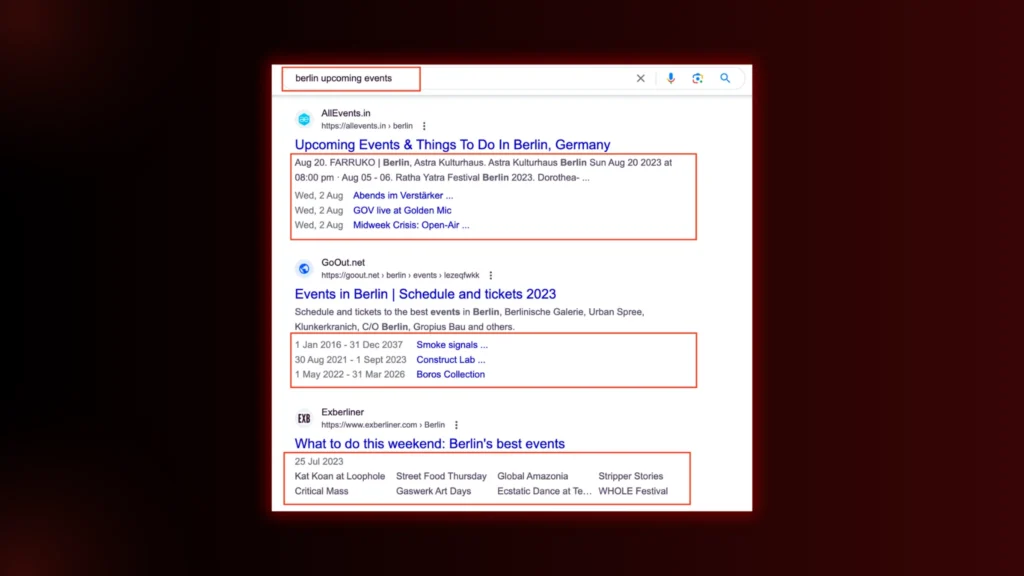Imagine searching for a product online. Instead of a plain blue link, you see star ratings, price, and availability right on the search page.
Or maybe you’re looking for a local service. The search result shows the business’s location, hours, and contact details at a glance.
That’s the power of schema markup. It’s a simple but effective SEO technique. With schema, you can get rich snippets. These include ratings, images, and event info. They make your listing more attractive.
But how to leverage schema markup for SEO? Let’s answer this question in this blog post.
What is Schema Markup for SEO
It is actually a type of structured data. It helps search engines understand your website’s content better. It improves your visibility in search results. It also leads to rich snippets—enhanced search listings with extra details.
These snippets increase click-through rates or CTR. Better search engine categorization and content indexing become possible through the appropriate organization of your content.

Benefits of Schema Markup
So you add schema, but are there any benefits you can gain from it in the long run? What makes it the talk of the town in the SEO world?
We will discuss all of this in the section below. Let’s have a look:
1. Better Visibility:
Schema markup allows search engines to display rich snippets. It can really increase your site’s visibility SERPs.
So, it is a way to make your site stand out in search results. Rich snippets can increase CTR by up to 40% compared to regular listings.
2. Higher User Engagement:
Rich snippets provide extra details. This means that users are more likely to click. Isn’t it?
For example, FAQ-rich results have an average CTR of 87%.
3. Clearer Communication with Search Engines:
Schema markup gives search engines precise data about your content. This can help with features like Google’s Knowledge Graph and voice search responses.
4. Increased Brand Trust:
Detailed listings look more credible. Users tend to trust your brand when they view results that present structured information.
Types of Schema Markup
There are tons of schema types—over 800 on Schema.org! But don’t worry, Google only supports a handful.
Why? Well, not all of them are useful for search results. Some are super niche, while others help websites in different ways.
Let’s talk about a few important ones. We’ll also show you how they’re used so you get a better idea.
1. Organization Schema
The first one is the Organization schema. It is a structured data markup that provides search engines with key details about a company or organization.
This includes:
- The organization’s name
- Logo
- Website URL
- Contact information
- Social media profiles

2. Person Schema
The person schema is used to mark up individual profiles. It provides search engines with information about a person. It includes:
- Name
- Job title
- Contact details

3. Place Schema
The place schema provides general location information. It can be used for various types of locations, such as landmarks or geographical areas.

4. LocalBusiness Schema
The LocalBusiness schema format details local business information through a specific markup structure.
You may have noticed that specific details appear at the top of the SERP when you search for certain service businesses online.
This happens because the schema is enabled. Basically, this schema helps display:
- Services
- Operating hours
- Locations

5. Product Schema
This schema provides detailed information about products available for sale on a website. It shows:
- Price
- Availability
- Descriptions

How to Leverage Schema Markup for SEO
1. Choose the Right Schema:
The choice of schema varies based on your needs. For example, for a Local Business, use the LocalBusiness Schema. For an E-commerce Store, use Product Schema.
So, The first step of schema implementation is getting to know the most suitable schema type! Pick the most relevant type from Schema.org.
2. Add Structured Data to Your HTML:
Next, you need to add your data to the HTML. Google recommends JSON-LD format. You can also use Microdata or RDFa.
Here’s an example of product schema using JSON-LD:

3. Test Your Markup:
You need to check the schema markup after its implementation. It’s a way to see if it is added successfully. You can try Google’s Rich Results Test to check for errors.
4. Monitor Your Search Performance
Once you’ve added schema markup, don’t just set it and forget it. Regularly check how it impacts your overall performance.
Use Google Search Console to see if your rich snippets appear in search results. If they’re missing, there might be an issue with your schema implementation.
Pay attention to your click-through rate (CTR) and impressions. If they are improving, your schema is working well. If not, review your markup, make adjustments, and test again.
SEO is an ongoing process. Small tweaks can make a big difference over time.
5. Keep Your Schema Updated
Schema markup is constantly evolving. Schema.org frequently adds new schema types and updates existing ones. Staying updated ensures you don’t miss important improvements.
Google also updates its structured data guidelines. Following the latest best practices keeps your site optimized and competitive.
If you’re using a CMS like WordPress, plugins like Yoast SEO or Rank Math can automate schema updates. If not, you may need to update your code manually.
Make it a habit to review your schema markup regularly. Keeping it fresh helps maintain search visibility and improves your chances of getting rich results!
Best Practices for Schema Markup
Getting schema markup right can make a big difference in your SEO. Here are some simple yet powerful tips to follow:
1. Start Small
Don’t overwhelm yourself. Your first step should include business fundamental information such as name, address, and contact number (NAP). Only move to more complicated schema types after mastering the basics.
2. Be Specific
Use the most relevant schema type for your content. If you’re selling products, use Product Schema instead of a generic markup. The more accurate your schema, the better search engines will understand your site.
3. Keep It Clean
Avoid adding unnecessary or misleading data. Google values accuracy, and stuffing extra details won’t help—it might even get you penalized.
4. Monitor Performance
After implementing schema, track how it impacts your search results. Use tools like Google Search Console to see if rich snippets are appearing. If not, tweak your markup.
5. Use JSON-LD (Recommended by Google)
There are different ways to add schema, but JSON-LD is the easiest and most Google-friendly. It keeps your code cleaner and easier to manage.
6. Test Before You Publish
Always check your schema before making it live. Use Google’s Rich Results Test or the Schema Markup Validator to spot any errors.
7. Stay Updated
Schema markup evolves over time. Keep an eye on Schema.org and Google’s updates. It will help to be sure that you’re following the latest best practices.
8. Don’t Overdo It
Only use schema where it makes sense. Adding unnecessary markup won’t boost rankings and could confuse search engines. Keep it natural and relevant.
FAQs
1. How to boost your SEO by using schema markup?
Schema markup helps search engines understand your content better. It improves visibility in search results by displaying rich snippets. Use it to mark up important elements like reviews, events, or products.
2. How does schema markup affect SEO?
Schema markup doesn’t directly impact rankings but improves how your page appears in search results. It can increase CTR and drive more traffic.
3. How do I create a schema markup in SEO?
- Identify content types to mark up (articles, products, etc.).
- Use a schema generator or manually add code to your page.
- Implement the structured data in the HTML of your site.
- Test with Google’s Structured Data Testing Tool.
- Monitor performance in Google Search Console.
Final Thoughts
Schema markup is a very powerful SEO strategy. It enhances visibility, increases engagement, and improves user experience. By implementing it correctly, your site can gain a competitive edge in search results.
If you want our team of experts at Brand ClickX to help make your brand a success, contact us now.



